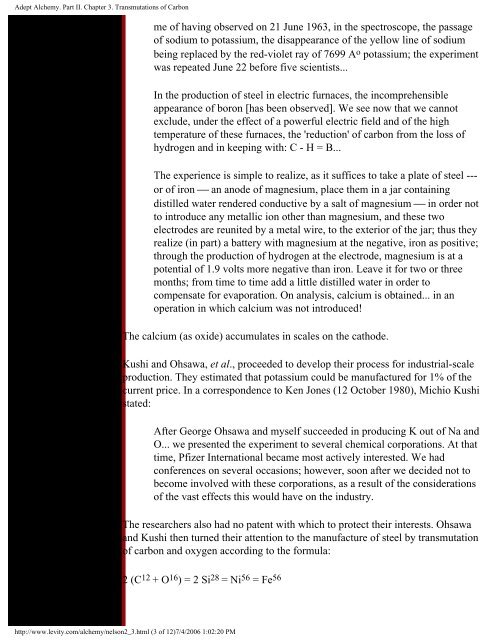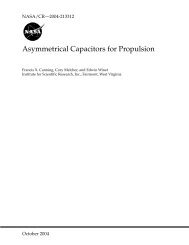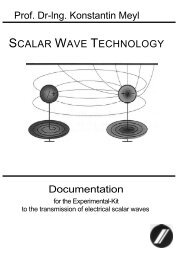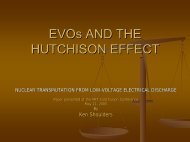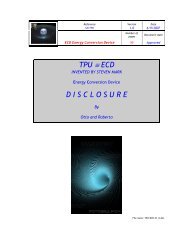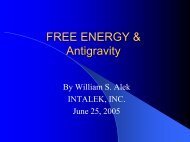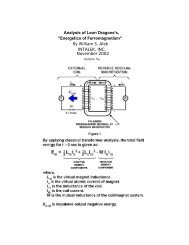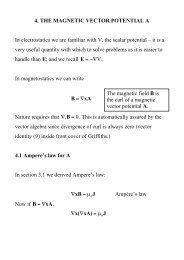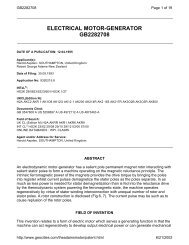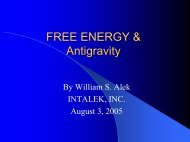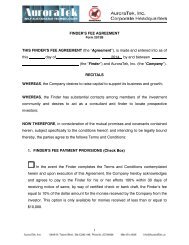The Transmutations of Carbon
The Transmutations of Carbon
The Transmutations of Carbon
You also want an ePaper? Increase the reach of your titles
YUMPU automatically turns print PDFs into web optimized ePapers that Google loves.
Adept Alchemy. Part II. Chapter 3. <strong>Transmutations</strong> <strong>of</strong> <strong>Carbon</strong>me <strong>of</strong> having observed on 21 June 1963, in the spectroscope, the passage<strong>of</strong> sodium to potassium, the disappearance <strong>of</strong> the yellow line <strong>of</strong> sodiumbeing replaced by the red-violet ray <strong>of</strong> 7699 A o potassium; the experimentwas repeated June 22 before five scientists...In the production <strong>of</strong> steel in electric furnaces, the incomprehensibleappearance <strong>of</strong> boron [has been observed]. We see now that we cannotexclude, under the effect <strong>of</strong> a powerful electric field and <strong>of</strong> the hightemperature <strong>of</strong> these furnaces, the 'reduction' <strong>of</strong> carbon from the loss <strong>of</strong>hydrogen and in keeping with: C - H = B...<strong>The</strong> experience is simple to realize, as it suffices to take a plate <strong>of</strong> steel ---or <strong>of</strong> iron ⎯ an anode <strong>of</strong> magnesium, place them in a jar containingdistilled water rendered conductive by a salt <strong>of</strong> magnesium ⎯ in order notto introduce any metallic ion other than magnesium, and these twoelectrodes are reunited by a metal wire, to the exterior <strong>of</strong> the jar; thus theyrealize (in part) a battery with magnesium at the negative, iron as positive;through the production <strong>of</strong> hydrogen at the electrode, magnesium is at apotential <strong>of</strong> 1.9 volts more negative than iron. Leave it for two or threemonths; from time to time add a little distilled water in order tocompensate for evaporation. On analysis, calcium is obtained... in anoperation in which calcium was not introduced!<strong>The</strong> calcium (as oxide) accumulates in scales on the cathode.Kushi and Ohsawa, et al., proceeded to develop their process for industrial-scaleproduction. <strong>The</strong>y estimated that potassium could be manufactured for 1% <strong>of</strong> thecurrent price. In a correspondence to Ken Jones (12 October 1980), Michio Kushistated:After George Ohsawa and myself succeeded in producing K out <strong>of</strong> Na andO... we presented the experiment to several chemical corporations. At thattime, Pfizer International became most actively interested. We hadconferences on several occasions; however, soon after we decided not tobecome involved with these corporations, as a result <strong>of</strong> the considerations<strong>of</strong> the vast effects this would have on the industry.<strong>The</strong> researchers also had no patent with which to protect their interests. Ohsawaand Kushi then turned their attention to the manufacture <strong>of</strong> steel by transmutation<strong>of</strong> carbon and oxygen according to the formula:2 (C 12 + O 16 ) = 2 Si 28 = Ni 56 = Fe 56http://www.levity.com/alchemy/nelson2_3.html (3 <strong>of</strong> 12)7/4/2006 1:02:20 PM


